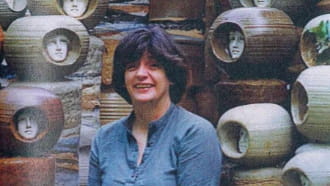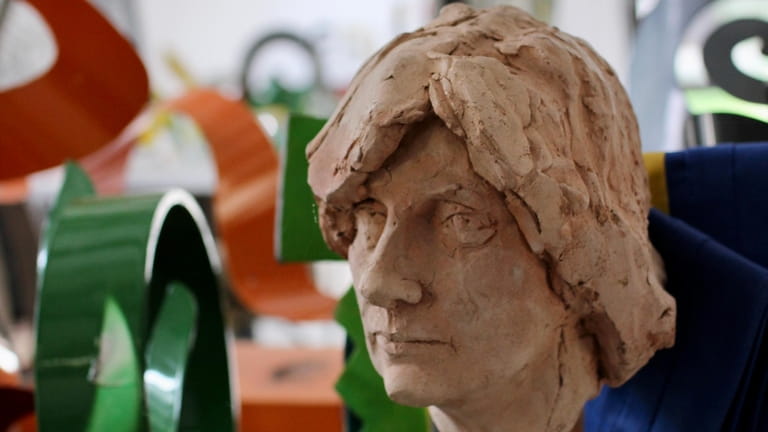Phyllis Baker Hammond honored with retrospective at J. Mackey Gallery in East Hampton
Celebrated sculptor Phyllis Baker Hammond with her vibrant aluminum sculptures "Break Thru" and "Concentric Bird" at the J. Mackey Gallery in East Hampton. Credit: J.Mackey Gallery East Hampton / Amie Hollmann
‘I always joke that I was trespassing,” said Justine McEnerney about the summer day in 2018 when she turned off Springs Fireplace Road onto a gravelly East Hampton driveway.
Lured by the tall, shiny, free-form sculptures lining the private path leading to a studio entrance, her plan was to find out if a smaller version of the brightly colored sheet-metal assemblages was available for her to purchase. What she discovered was not only an enchanting cache of powder-coated aluminum monuments, but an accumulation of work representing a lifetime of masterful artistic exploration.
“There were some unrealized mixed-media pieces by the pool, old clay works behind bushes — it was like a magical garden,” recalled McEnerney, who was then the gallery manager at Concordia College’s OSilas Gallery in Bronxville.
Today, McEnerney owns J. Mackey Gallery in East Hampton, where the first-ever full retrospective is being held to honor the work of the sculptor she met that fateful day, Phyllis Baker Hammond. The exhibition, “Phyllis Baker Hammond: Take Flight,” is on view through Sept. 1 and traces the 94-year-old’s remarkable creative trajectory — from the thrown clay vessels she started to make in Japan in the 1950s, to her commanding bronze angels of the 1970s and ’80s, to the large aluminum abstractions she began shaping with a hammer and anvil in her East End studio as an octogenarian.
Among Hammond’s numerous high-profile projects is “Beyond the Edge,” a five-sculpture series installed in 2017 at Dag Hammarskjöld Plaza in front of the United Nations Headquarters in Manhattan, and “Redefining Space,” created in 2009 for the Peace Garden at the Tokiwa Museum in Ube, Japan, commemorating the bombing of Nagasaki. (Hammond turned down an invitation to participate in the Venice Biennale to complete the Ube project.)
She is also the designer of the Will Award (presented by the Shakespeare Theatre Company to the likes of Michael Kane and Maggie Smith), has made ceramics for Corning and Neiman Marcus, and was a pioneer of art therapy for the mentally and physically disabled.
“She reinvented herself again and again and again,” said McEnerney, labeling the veteran sculptor “a walking art form,” not least because of her predilection for hot-pink sneakers and puffer jackets.
That boldness has been increasingly expressed by Hammond over the arc of her career, as evidenced by the growth in size and complexity of her sculptures despite the physical challenges it has presented in her later years.
The artist attributed the phenomenon to mounting self-assurance. “I love making three-dimensional forms. They gave me joy and they gave me confidence in myself,” she said from her home in Los Angeles, where she has lived since October to be closer to family.

Hammond surrounded by her "Contained" series of faces in clay. Credit: Phyllis Hammond
The vibrant, larger-than-life creations Hammond has made late in life stand in stark and telling contrast to her early pieces. Starting as a ceramicist, she made hand-built and wheel-thrown sculpture, often with faces imprisoned in cylinder and jug-shaped forms. “They reflected the feeling she had of being closed in, the feeling, as a woman sculptor, of not always being respected,” said McEnerney.
Said Hammond, sitting in McEnerney’s gallery last fall, “I felt the kind of liberation to be able to control that moving potter’s wheel for that clay form that was really quite, quite exciting. And to be able to have that skill to make that pottery, to make that piece sing in space, was really a revelation.”
LIFELONG LOVE OF ART
Born in Elizabeth, New Jersey, and raised outside Boston, Hammond often made the trip downtown as a young child to sketch the Greek and Roman figurative sculptures at the Museum of Fine Arts. “I love to draw. I was drawing constantly. And saving pictures and putting them on the wall,” she recalled.
Hammond became interested in working with clay in Okinawa, where she lived with her second husband, Gerald Lynch, who was stationed there during the Korean War. While the marriage didn’t last, her passion for clay did, and she enrolled in pottery classes upon her return to the United States.
Divorced and with a young child — her daughter Sharon was born in 1952 — Hammond returned to Boston to pursue her bachelor’s and master’s degrees at the School of the Museum of Fine Arts, along with a degree in education at Tufts University. During that time, Hammond was also awarded a one-year traveling scholarship, which she chose to spend back in Japan.
“We stayed in Tokyo for a few months, where she taught English to members of the Economic Society, and then we went on to Kyoto, where she studied at the college of fine arts,” recalled her daughter Sharon Lynch, who was 9 at the time. “I feel her sculptures of people inside containers were influenced in part by Japanese ‘kokeshi,’ wooden dolls with no arms and legs.”
According to Hammond, the time she spent in Japan was transformative. “It liberated me as a woman to study there and as an American,” she explained in a 1978 New York Times article. “I learned about a new culture, looked at my work in reference to it, and came home free to be myself.”
Landing in New York City, Hammond worked as a freelance tableware designer and as an art therapist, helping others with their own journeys of self-realization. “I worked with handicapped children at Bellevue Hospital, children who have been plagued with disease and really had very difficult lives,” she said. “I encouraged them to do self-portraits, and they loved it.”
A bronze from Hammond's "Angels" series and an orange aluminum sculpture from her "Flight" series at her former Springs home. Credit: J.Mackey Gallery East Hampton / Amie Hollmann
In 1971, Hammond moved with her third husband, William Hammond, to Briarcliff Manor in northern Westchester. With her own studio and a large walk-in kiln, she began to expand the themes and dimensions of her stoneware.
“Her latest urns are freer, the edges unfurled,” wrote a New York Times critic. “More and more, she is moving toward nonobjective pieces, combining wheel-thrown forms, slabs and coil building.”
In a recent interview, Hammond explained of her work, “As they grew in size and stature, they grew in freedom. More discipline was required. More realism and playing with the forms and the continual surface textures. It’s like they’re opening up there.” They’re like unfolding forms.”
Eventually, she crafted the forms in wax to make molds for large bronzes, including the two multi-figure groups comprising “Phoenix” that frame the steps of the Connecticut Department of Environmental Protection offices in Hartford.
“For the faces she made plaster casts of people, who would have to lay there with straws up their noses and Vaseline all over their faces. She used mine and her own,” said Lynch. “She also made casts of mannequins. I had a friend who was in the visual merchandising department at Macy’s who got her permission to use them.”
INSPIRED BY ‘DOODLES’
In 1985, Hammond married her current husband, Aldo Perotto, a physician. Soon after, the couple bought a summer place in Springs and, upon Perotto’s retirement in 1995, constructed a year-round home in the East Hampton hamlet. The structures were designed by Charles Forberg, the architect behind LongHouse Reserve, the nearby Japanese-style residence of the late textile designer Jack Larsen.

Self-portrait study in clay at Phyllis Baker Hammond's studio in Springs. Credit: J.Mackey Gallery East Hampton / Amie Hollmann
Hammond’s studio, a lofty prefab space with four glass garage doors, was built when she was 83 and signaled a significant shift in her art-making, one that continued to draw on her fearless personality and penchant for playful experimentation.
It also drew on an assignment she conceived for an adult education class she was teaching in Sag Harbor at the time. She encouraged her students to scribble, or “doodle,” on large sheets of paper and then color, cut and reassemble the forms to create their own dynamic sculptures.
“Whenever I have time, I do a lot of doodling,” she said in a visit to J. Mackey Gallery. “There’s a lot of variety and playfulness and bending and turning and twisting and mainly experimenting with forms and color. I call it doodling because it takes away from the preciousness. But, you know, it is precious.”
Hammond began to scan her pencil drawings into a computer, converting them into a vector program that could be read by a waterjet machine able to cut the shapes from large metal sheets. The process harks back to schematic circuit-board drawings she made as a college student working at a mainframe computer company.
Eventually Hammond became as intrigued by the throwaway scraps as her primary configurations, using them to fabricate wall pieces such as “Yellow Positive” and “Blue Dimension,” which are featured in the current show, as well as two-part freestanding assemblages in which one element is fashioned from forms that are cut from the other. “She sees the positive and negative spaces as equally important,” said McEnerney.
To complete these works, Hammond took the aluminum cut-outs first to Liberty Iron Works in Southampton, where they were fed, under her direction, through a rolling machine, and finally to Ultimate Powder Coating in Shirley to receive their bright automotive paint veneer.
Although the attention-grabbing colors of these abstractions stand in striking contrast to the muted, organic tones of her earlier imagery, Hammond sees a direct connection between the two.
“[They] could be strange flowers or birds or people from some other unheard-of planet,” Hammond wrote in an artist statement for Kiesendahl + Calhoun Fine Art, a Pennsylvania gallery that is selling some of her work, about her latest playfully conceived sculptures. “The forces of memory and imagination brings me to the place at the beginning of my career, full of energy and enthusiasm.”
Looking back at Hammond’s seven decades of whimsy and work, it is clear she never lost her moxie.
McEnerney, 48, who founded her gallery just two years ago, agreed. “Phyllis inspires you to chase your dreams — at any age.”
THE RETROSPECTIVE
“Phyllis Baker Hammond: Take Flight” is on view at the J. Mackey Gallery | East Hampton through Sept. 1. The gallery is open from 10:30 a.m. to 6 p.m. Saturday and Sunday, and by appointment Monday through Friday. It is located at 62 The Circle, East Hampton. Call 917-592-8568 for more information.
Updated 18 minutes ago Teacher pay ... Trump in court today ... Santos' request to unseal witness statements ... Autism walk
Updated 18 minutes ago Teacher pay ... Trump in court today ... Santos' request to unseal witness statements ... Autism walk
